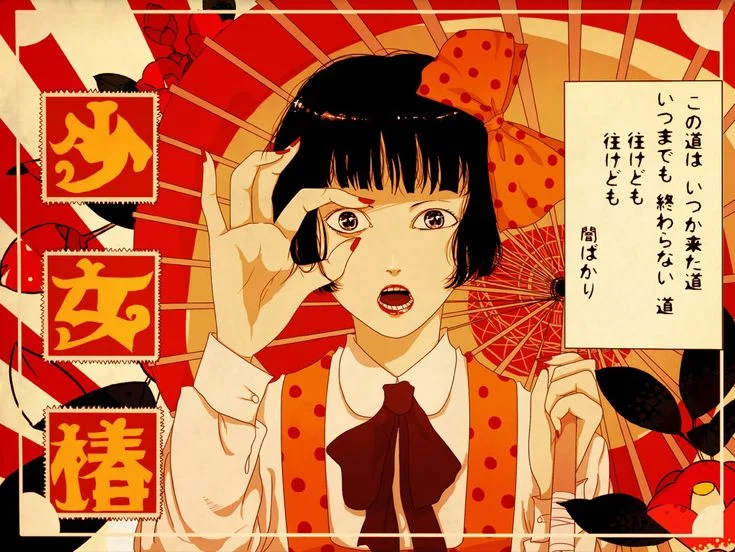“Midori: The Girl in the Freakshow,” originally known as Shōjo Tsubaki in Japan, is a 1992 anime film that stands out for its disturbing and controversial content. Directed by Hiroshi Harada, this film is an adaptation of Suehiro Maruo’s manga of the same name. Despite its limited release, “Midori” has carved a niche for itself in the anime community, often discussed for its dark themes and the impact it leaves on its viewers.

Background and Synopsis
The story of “Midori: The Girl in the Freakshow” is a harrowing tale of a young girl named Midori who, after losing her parents, is taken in by a traveling circus. However, this circus is no ordinary one; it is a grotesque freakshow where the performers are deformed and deranged individuals. Midori is subjected to severe abuse and exploitation, forced to endure unimaginable horrors as she tries to survive in this cruel environment.
The plot delves deep into the themes of exploitation, abuse, and the loss of innocence. As Midori navigates her grim reality, the film paints a bleak picture of her world, filled with suffering and despair. The narrative is not for the faint of heart, as it explores the darkest corners of human experience, leaving a lasting impact on those who watch it.
Production and Release
The production of “Midori: The Girl in the Freakshow” was as unconventional as the film itself. Directed by Hiroshi Harada, the anime was a passion project with a minimal budget. Harada not only directed but also financed the film, which resulted in a unique yet disturbing visual style that perfectly complemented the dark narrative.
However, the production was fraught with challenges. Due to its graphic content, finding distributors willing to release the film was an uphill battle. The film faced significant resistance due to its explicit portrayal of violence and abuse, which led to its extremely limited release. This limited availability has contributed to the film’s status as a cult classic, known only to a select group of anime enthusiasts.
Themes and Symbolism
At its core, “Midori: The Girl in the Freakshow” is a deeply symbolic film. It explores the themes of societal marginalization, abuse, and the struggle for survival in an unforgiving world. The characters in the freakshow, including Midori herself, represent those who are cast aside by society, forced to live on the fringes in a world that refuses to acknowledge their existence.
The film’s use of grotesque imagery and disturbing scenes serves as a stark commentary on the darker aspects of human nature. The freakshow becomes a microcosm of a world where the weak are preyed upon, and survival comes at the cost of one’s humanity. This symbolism is central to the film’s narrative, making it a powerful, albeit unsettling, experience.
Controversy and Censorship
“Midori: The Girl in the Freakshow” has been the subject of much controversy since its release. The film’s graphic depiction of violence, abuse, and sexual exploitation led to widespread condemnation and censorship. In many countries, the film was either heavily edited or outright banned, making it difficult for audiences to access it.
Censorship issues have played a significant role in the film’s limited distribution. The disturbing content, which includes scenes of extreme violence and psychological torment, was deemed too shocking for general audiences. As a result, “Midori” remains a relatively obscure title, known primarily to those with a deep interest in anime’s more avant-garde offerings.
Despite this, the film has managed to survive in underground circles, where it is often discussed and debated. Today, “Midori” can be found online, but viewers are advised to approach it with caution, given its intense and unsettling content.
Critical Reception
The critical reception of “Midori: The Girl in the Freakshow” has been polarized. While some praise the film for its artistic daring and willingness to explore taboo subjects, others criticize it for being overly gratuitous in its depiction of violence and suffering. The film’s unique animation style, which combines traditional techniques with a hauntingly surreal aesthetic, has also been a point of discussion.
Over the years, “Midori” has gained a cult following, with fans appreciating its bold narrative and uncompromising approach to storytelling. The film’s influence can be seen in later works that explore similar themes of horror and psychological trauma. Despite its divisive nature, “Midori” remains an important work in the history of anime, representing a rare example of a film that pushes the boundaries of what animation can achieve.
'Midori: Shojo Tsubaki' (1992) a horrific Japanese animated freakshow.
byu/AZUR3WRATH inhorror
Conclusion
“Midori: The Girl in the Freakshow” is not a film for everyone. Its disturbing content and bleak themes make it a challenging watch, but it is precisely these elements that have cemented its place in anime history. For those interested in exploring the darker side of animation, “Midori” offers a unique and unforgettable experience.
The film’s legacy is one of controversy and intrigue, with its status as a cult classic ensuring that it continues to be discussed and analyzed by anime fans. While it may not be a mainstream hit, “Midori: The Girl in the Freakshow” is a film that leaves a lasting impression, reminding us of the power of animation to tell stories that are both disturbing and deeply thought-provoking.

Akane, known as akanecco._ on Instagram, is a passionate and experienced Anime creator specializing in anime content. With 317 engaging posts and a dedicated following of 12.7K, Akane has become a trusted authority in the anime community. Through detailed reviews, character explorations, and insightful analyses, Akane shares an extensive knowledge of anime, captivating and educating fans with every video. Follow Akane on Instagram to immerse yourself in the vibrant world of anime and join a community of like-minded enthusiasts here- Facebook and Pinterest.





